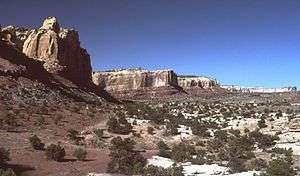Wingate Sandstone
The Wingate Sandstone is a geologic formation in the Glen Canyon Group of the Colorado Plateau province of the United States which crops out in northern Arizona, northwest Colorado, Nevada, and Utah.
| Wingate Sandstone Stratigraphic range: Late Triassic to Early Jurassic | |
|---|---|
 Wingate Sandstone cliffs in the San Rafael Swell, Utah | |
| Type | Geological formation |
| Underlies | Kayenta Formation |
| Overlies | Chinle Formation |
| Lithology | |
| Primary | Eolian sandstone |
| Location | |
| Region | Colorado Plateau |
| Country | United States |
| Type section | |
| Named for | Fort Wingate |
| Named by | C.E. Dutton |
Geology
Wingate Sandstone is particularly prominent in southeastern Utah, where it forms attractions in a number of national parks and monuments. These include Capitol Reef National Park, the San Rafael Swell, and Canyonlands National Park.
Wingate sandstone frequently appears just below the Kayenta Formation and Navajo Sandstone, two other formations of the Glen Canyon group. Together, these three formations can result in immense vertical cliffs of 2000 feet (609 meters) or more. Wingate layers are typically pale orange to red in color, the remnants of wind-born sand dunes deposited approximately 200 million years ago in the Late Triassic.
Fossils
Long dated to the Early Jurassic only, fossils (including a phytosaur skull) and other evidence indicate that part of the Wingate Sandstone is as old as Late Triassic in age. The upper part of the formation, which laterally interfingers with the Moenave Formation to the west, is Early Jurassic in age.[1][2]
References
- Lucas, S. G., A. B. Heckert, J. W. Estep, and O. J. Anderson. 1997. Stratigraphy, biostratigraphy, and sequence stratigraphy of the Upper Triassic Chinle Group, Four Corners region. Pages 81-107 in Anderson, O. J., B. Kues, and S. G. Lucas, editors. Mesozoic geology and paleontology of the Four Corners Region. New Mexico Geological Society, Socorro, NM. New Mexico Geological Society, 48th Field Conference.
- Lucas, S. G., A. B. Heckert, and L. H. Tanner. 2005. Arizona’s Jurassic fossil vertebrates and the age of the Glen Canyon Group. Pages 95-104 in Heckert, A. B. and S. G. Lucas (editors). Vertebrate paleontology in Arizona. New Mexico Museum of Natural History and Science, Albuquerque, NM. Bulletin 29.